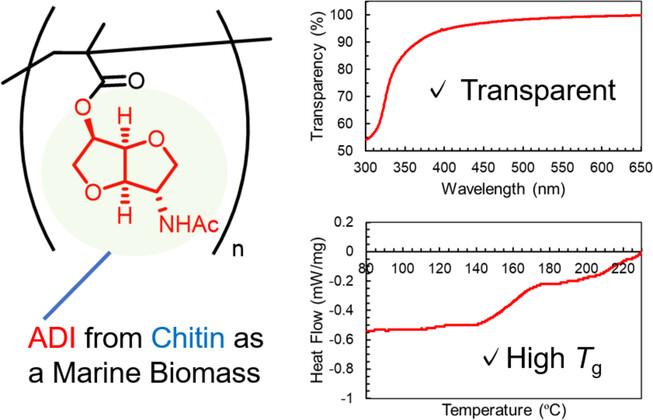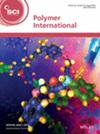Yasuhito Koyama, Takuya Sagawa, Kazufumi Kohno, Kento Sato, Hirokazu Kobayashi, Atsushi Fukuoka
求助PDF
{"title":"Synthesis and properties of biomass-based polymethacrylate comprising chitin-derived 2-acetamide-2-deoxyisosorbide as a repeat unit","authors":"Yasuhito Koyama, Takuya Sagawa, Kazufumi Kohno, Kento Sato, Hirokazu Kobayashi, Atsushi Fukuoka","doi":"10.1002/pi.6701","DOIUrl":null,"url":null,"abstract":"<p>Synthesis and applications of biobased polymers have been extensively studied in order to reduce the use of petroleum-based polymers and likewise environmental load. Several biobased polymers have been produced on a commercial large scale to date. However, the lineup of biobased high-performance polymers with transparency and high glass transition temperature is inadequate and their development is a critical issue. In this article, we design a new biobased polymethacrylate comprising rigid <i>cis</i>-fused bicyclic 2-acetamide-2-deoxyisosorbide (ADI) as a repeat unit. We have recently invented catalytic transformation systems from chitin as a marine biomass to ADI as a new nitrogen-containing platform chemical. The ADI-based polymethacrylate is synthesized via free radical polymerization of the methacrylic acid ester of ADI initiated by (NH<sub>4</sub>)<sub>2</sub>S<sub>2</sub>O<sub>8</sub> and <i>N</i>,<i>N</i>,<i>N</i>′,<i>N</i>′-tetramethylethylenediamine in dimethylsulfoxide–H<sub>2</sub>O mixed solvent. The molecular weight and its dispersity are estimated by size exclusion chromatography on the basis of polymethylmethacrylate standards. UV–visible spectroscopy demonstrates the high transparency of the polymer in the visible wavelength region. Differential scanning calorimetry analysis of the polymer clarifies the remarkably high glass transition temperature, compared with that of polymethylmethacrylate. The thermal decomposition temperature of the polymer is also evaluated by thermogravimetric analysis. On the basis of the favorable properties of the ADI-based polymer, the present study proposes it as a nitrogen-containing biobased polymer useful for real-world applications. © 2024 Society of Chemical Industry.</p>","PeriodicalId":20404,"journal":{"name":"Polymer International","volume":"74 10","pages":"898-904"},"PeriodicalIF":3.6000,"publicationDate":"2024-09-24","publicationTypes":"Journal Article","fieldsOfStudy":null,"isOpenAccess":false,"openAccessPdf":"","citationCount":"0","resultStr":null,"platform":"Semanticscholar","paperid":null,"PeriodicalName":"Polymer International","FirstCategoryId":"92","ListUrlMain":"https://scijournals.onlinelibrary.wiley.com/doi/10.1002/pi.6701","RegionNum":4,"RegionCategory":"化学","ArticlePicture":[],"TitleCN":null,"AbstractTextCN":null,"PMCID":null,"EPubDate":"","PubModel":"","JCR":"Q2","JCRName":"POLYMER SCIENCE","Score":null,"Total":0}
引用次数: 0
引用
批量引用
Abstract
Synthesis and applications of biobased polymers have been extensively studied in order to reduce the use of petroleum-based polymers and likewise environmental load. Several biobased polymers have been produced on a commercial large scale to date. However, the lineup of biobased high-performance polymers with transparency and high glass transition temperature is inadequate and their development is a critical issue. In this article, we design a new biobased polymethacrylate comprising rigid cis -fused bicyclic 2-acetamide-2-deoxyisosorbide (ADI) as a repeat unit. We have recently invented catalytic transformation systems from chitin as a marine biomass to ADI as a new nitrogen-containing platform chemical. The ADI-based polymethacrylate is synthesized via free radical polymerization of the methacrylic acid ester of ADI initiated by (NH4 )2 S2 O8 and N ,N ,N ′,N ′-tetramethylethylenediamine in dimethylsulfoxide–H2 O mixed solvent. The molecular weight and its dispersity are estimated by size exclusion chromatography on the basis of polymethylmethacrylate standards. UV–visible spectroscopy demonstrates the high transparency of the polymer in the visible wavelength region. Differential scanning calorimetry analysis of the polymer clarifies the remarkably high glass transition temperature, compared with that of polymethylmethacrylate. The thermal decomposition temperature of the polymer is also evaluated by thermogravimetric analysis. On the basis of the favorable properties of the ADI-based polymer, the present study proposes it as a nitrogen-containing biobased polymer useful for real-world applications. © 2024 Society of Chemical Industry.
以几丁质衍生的2-乙酰胺-2-脱氧异山梨酯为重复单元的生物质基聚甲基丙烯酸酯的合成与性能
为了减少石油基聚合物的使用和环境负荷,生物基聚合物的合成和应用已经得到了广泛的研究。到目前为止,几种生物基聚合物已经在商业上大规模生产。然而,具有透明和高玻璃化转变温度的生物基高性能聚合物的阵容不足,其开发是一个关键问题。在这篇文章中,我们设计了一种新的生物基聚甲基丙烯酸酯,包括刚性顺熔双环2-乙酰酰胺-2-脱氧异山梨酯(ADI)作为重复单元。我们最近发明了催化转化系统,从几丁质作为海洋生物质到ADI作为一种新的含氮平台化学品。以(NH4)2S2O8和N,N,N ',N ' -四亚甲基乙二胺为起始溶剂,在二甲亚砜-水混合溶剂中自由基聚合,合成了ADI基聚甲基丙烯酸酯。以聚甲基丙烯酸甲酯标准物为基础,用粒径排阻色谱法测定其分子量和分散性。紫外可见光谱显示了聚合物在可见波长区域的高透明度。差示扫描量热分析表明,与聚甲基丙烯酸甲酯相比,该聚合物的玻璃化转变温度非常高。用热重法测定了聚合物的热分解温度。基于adi基聚合物的良好性能,本研究提出它是一种具有实际应用价值的含氮生物基聚合物。©2024化学工业学会。
本文章由计算机程序翻译,如有差异,请以英文原文为准。




 求助内容:
求助内容: 应助结果提醒方式:
应助结果提醒方式:


